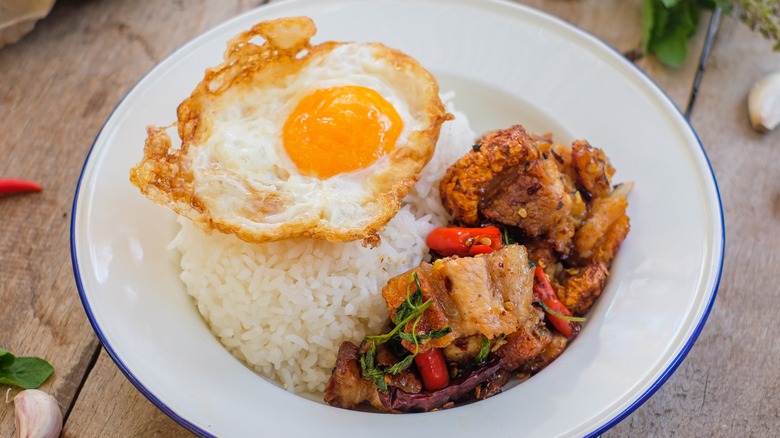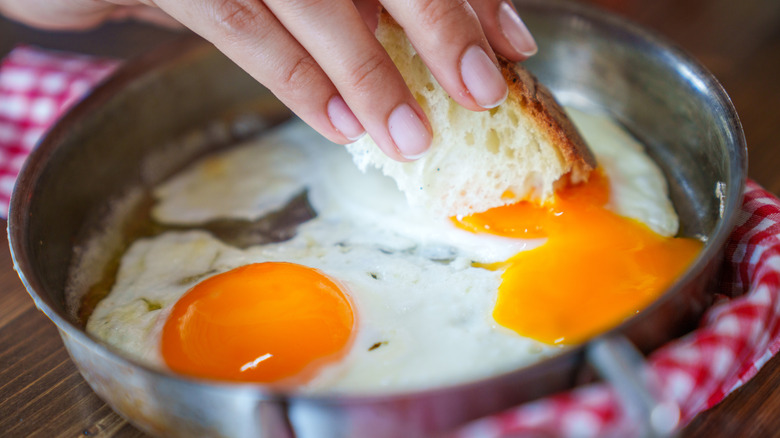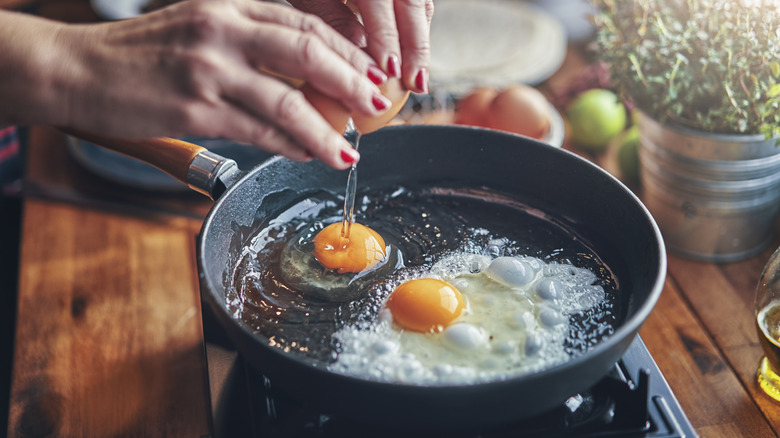Baste Fried Eggs In Oil For Absurdly Crispy Edges
Fried eggs are among the simplest recipes you can whip up in the kitchen — just crack an egg into a greased skillet, let it cook for a few minutes, and you're good to go! But if you strive for perfection in your meals, just a passing fry or a sprinkle of seasoning on the egg won't do, especially if you like your fried egg on the crispy side. Here's a trick to try in that case: Baste the egg in its oil as it's frying!
No need for extra ingredients or any complicated technique. Just use a spoon to ladle up the cooking oil that the egg is frying in, then drizzle it over the top of the egg — it's not unlike how you'd baste the steak in clarified butter if you're making pan-seared steak. Don't discount this technique just because it's so simple at face value, though. The crispy edges of the egg you'd get by the end won't be like anything you've fried up before.
The science behind a fried egg
Before getting to that, let's take a look at exactly what happens when you crack a fresh egg into a pan of hot oil. As soon as the egg hits the oil, the water within evaporates, and the egg proteins denature. This rapid process transforms the translucent egg white into the telltale white hue of a nicely cooked egg.
As the egg continues to cook, you'll soon notice brown, crispy spots forming on the edges and underside. This is the Maillard reaction in action! Apart from providing a satisfying crunch, it imparts that distinct savory flavor associated with fried foods. Since the edge of the egg is thinner and directly contacts the oil, the reaction occurs on the edge first before slowly working its way up the egg. However, be careful not to leave it on the heat for too long, even if it's in the ideal temperature range for frying eggs, or the edge may become charred.
With that in mind, to improve the crispiness of your fried egg, what you'll want to do is promote the Maillard reaction — the stronger it is, the crispier it's going to be. You can do exactly that by giving the egg a top-to-bottom oil bath.
Basting helps the egg cook more evenly
Once you've cracked your egg (at room temperature to avoid overcooking the eggs) and it's cooking, grab a spoon and scoop up some oil of your choice. While the egg is cooking, drizzle the oil from the center of the egg and all around the top side. The hot oil acts like a direct, intense heat applied right to the top side. Since the top side isn't in direct contact with the hot oil, it doesn't cook as quickly as the underside of the edges. This is why you might sometimes find raw egg whites around the edges. Adding oil to the top side brings it up to speed with the rest of the egg. As the heat spreads to the edges, it encourages them to crisp up even more.
Gordon Ramsay often uses this technique when he makes fried eggs. In a cooking demonstration for HexClad Cookware, he put his own twist on the method. Instead of using cooking oil, he clarified some butter in the pan and used it as the frying medium for the egg. With a spoon, he basted the outer rim of the egg, resulting in a beautiful, golden-brown halo surrounding the egg. It's bound to give a satisfying crunch when you take a bite.


